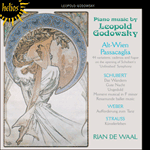
Welcome to Hyperion Records, a British classical label devoted to presenting high-quality recordings of music of all styles and from all periods from the twelfth century to the twenty-first.
Hyperion offers both CDs, and downloads in a number of formats. The site is also available in several languages.
Please use the dropdown buttons to set your preferred options, or use the checkbox to accept the defaults.

| Rian De Waal (piano)» More |
Abram Chasins, who knew Godowsky well at this time, recalled in his book Speaking of Pianists the evening when he, along with a few others (including the great Josef Hofmann), gathered in Godowsky’s apartment in New York to hear the work for the first time. The composer played it from green-coloured proof sheets stacked on the piano rack. ‘And how he played! This was sheer enchantment, both the work itself and Godowsky’s pianism. It had the cool, colorful clarity of a stained-glass window. Although I was greatly moved and impressed by what I heard, Godowsky’s effortless mastery made me unaware of the vastness of his pianistic feat that night. Years later I realized it when one of the great virtuosos told me he had worked on the “fiendish piece” for a year, several hours each day, and had finally given up the unequal struggle. “It is impossible to master”, he said. I felt tactful that day and refrained from telling him with what devastating ease Godowsky had disposed of it, making it seem like nothing at all.’ Simon Barere played it, Vladimir Horowitz prepared it but never programmed it (though his reported excuse for not doing so—‘It needs six hands to play it’—is surely a comment on something other than his digital ability). Yet until recently very few had tackled it in public. Godowsky gave its London premiere at the Queen’s Hall in April 1928; Rian de Waal gave its second London performance in April 1991.
from notes by Jeremy Nicholas © 1991
Abram Chasins, qui connaissait bien Godowsky à cette époque-là, rappelle dans son livre Speaking of Pianists le soir où, avec quelques amis (parmi lesquels le grand Josef Hofmann), ils se réunirent dans l’appartement de Godowsky pour entendre le morceau pour la première fois. Le compositeur le joua en déchiffrant des épreuves de couleur verte, entassées sur le chevalet. «Et comme il le joua! C’était un pur enchantement, à la fois pour le morceau et pour la qualité pianistique de Godowsky. Cela avait la clarté pure et colorée d’un vitrail. Bien que je fusse fort ému et impressionné par ce que j’entendais, la maitrise aisée de Godowsky me cacha l’immensité de son exploit pianistique, ce soir-là. Bien des années plus tard, je m’en rendis compte quand un des grands virtuoses me dit qu’il avait travaillé «le diabolique morceau» pendant un an, plusieurs heures par jour et avait fini par abandonner cette lutte inégale. «Il est impossible à jouer», dit-il. J’étais plein de tact ce jour-là et ne lui révélai donc pas la facilité irrésistible avec laquelle Godowsky en avait disposé, nous faisant croire que ce n’était rien. Simon Barere l’a joué, Vladimir Horowitz l’a préparé mais ne l’a jamais inscrit à son programme (son excuse pour ne pas le faire—«Il faut six mains pour le jouer»—doit certainement être un commentaire sur plus que son habileté digitale). Pourtant, très peu s’y attaquèrent en public jusqu’à une période récente. Godowsky lui donna sa première à Londres au Queen’s Hall en avril 1928; Rian de Waal lui donna sa deuxime représentation à Londres en avril 1991.
extrait des notes rédigées par Jeremy Nicholas © 1991
Français: Elisabeth Rhodes
Abram Chasins, der damals gut mit Godowsky bekannt war, erinnert sich in seinem Buch Speaking of Pianists an den Abend, als er und einige andere (darunter der große Josef Hofmann) in Godowskys Wohnung in New York zusammenkamen, um das Werk zum ersten Mal zu hören. Der Komponist spielte es mit Hilfe der grünen Probeabzüge, die sich auf der Notenablage stapelten. „Und wie er spielte! Das war reine Zauberei, sowohl das Werk selbst, als auch Godowskys Klavierspiel. Es hatte die kühle, farbige Klarheit eines Buntglasfensters. Obwohl ich von dem, was ich hörte, sehr bewegt und beeindruckt war, ließ mich Godowskys mühelose Meisterschaft die ungeheure pianistische Leistung übersehen, die er an jenem Abend vollbrachte. Jahre später kam mir die Erkenntnis, als mir ein bedeutender Virtuose anvertraute, er habe an dem ‘teuflischen Machwerk’ ein Jahr lang mehrere Stunden täglich gearbeitet und schießlich den ungleichen Kampf aufgegeben. ‘Es ist unmöglich zu bewältigen’, sagte er. Ich war damals taktvoll und enthielt mich, ihm von der erschütternden Leichtigkeit zu erzählen, mit der Godowsky es heruntergespielt hatte, als wäre nichts dabei.“ Simon Barere spielte es, Wladimir Horowitz übte es ein, setzte es jedoch nie als Programmpunkt an (seine angebliche Entschuldigung, es nicht zu tun—„Man braucht sechs Hände, um es zu spielen“—, bezieht sich gewiß auf etwas anderes als auf die eigene Fingerfertigkeit). Jedenfalls hatten es bis vor kurzem nur sehr wenige vor Publikum angegangen. Godowsky spielte im April 1928 in der Queen’s Hall die Londoner Uraufführung und Rian de Waal gab im April 1991 die zweite Aufführung überhaupt in London.
aus dem Begleittext von Jeremy Nicholas © 1991
Deutsch: Anne Steeb/Bernd Müller
 Godowsky: Piano Music Godowsky: Piano Music‘A musical as well as a technical revelation … De Waal's virtuosity is awe-inspiring, and he's complemented throughout by a beautifully natural a ... ‘This disc is amazing … wild stuff, to which Rian de Waal does ample justice’ (BBC Music Magazine)» More |

